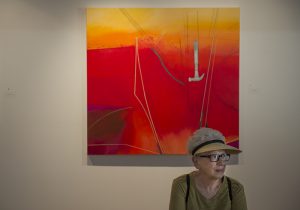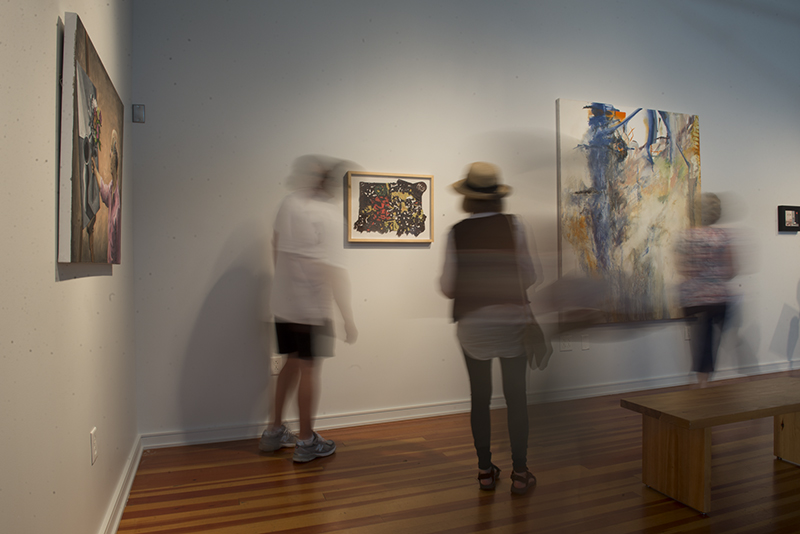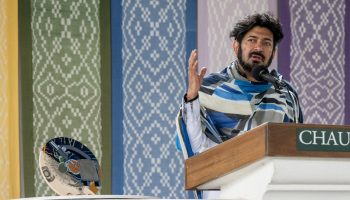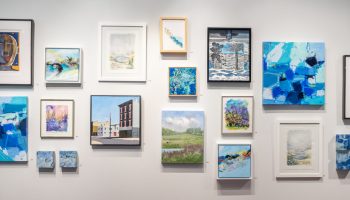By their very nature, juried exhibitions are eclectic affairs in which the selection process is bound to a number: the sum of the artists submitting their efforts for consideration. And so it goes for the 59th Annual Exhibition of Contemporary Art at Strohl Art Center, a collection of 28 artists chosen from a pool of 450 entrants from all over the country by Steven Harvey and Jennifer Samet, owner and co-director, respectively, of Steven Harvey Fine Arts Project located in the bustling gallery district on Manhattan’s Lower East Side.
Which isn’t to say that juried shows as a whole lack curatorial coherence. In fact, Harvey and Samet’s choices tend to favor representational works with Expressionist and/or Surrealist overtones, a stylistic thread that extends even to the several abstract and outwardly realistic pieces included here. This mix is characteristic of much of the work being done by the emerging artists who show in Lower East Side galleries, including Harvey’s own.
Those qualities are apparent, for example, in a painting by Virginia Sharkey titled “Monday.” Winner of this year’s Bellinger Award, the Annual’s top prize, “Monday” consists of a fiery, overall field of orange shading into red, crossed by lines that curve, bend and in some cases, slice down the face of the composition like surgical incisions. Those are meant, presumably, to break up the surface into geometric planes, with one corner dropping off into an illusion of perspective, as if what we’re seeing floats against a largely unseen void. Sharkey’s work, though, doesn’t appear to be a mere formalist exercise, as its fierce hues — and the presence of a hammer rendered in ghostly black-and-black in the canvas’ upper right quadrant — suggests something much more troubling. The artist describes her work as existential, in which case, “Monday” would appear to be a bad day, indeed.
The Annual’s runner-up VACI Partner Award goes to Tracy Hoffman’s color photomontage, “Helen Frankenthaler on 21st Street and the Dot Motif,” which, as the title suggests, is an homage to the renowned color field painter — one of the few women working in the boy’s-club environment of New York’s postwar Abstract Expressionist scene. Hoffman’s piece centers on a photo of the artist in her studio sometime during the 1950s or ’60s. Seated in front of one of her paintings, she stares defiantly into the camera, pulling on a cigarette with one hand while holding a drink in the other. Her pose projects the same sort of self-mythologizing egoism embraced by the likes of Willem De Kooning and Jackson Pollock, though her tough-as-nails expression could also be construed as a feminist statement; in any case, her eyes betray a hint of vulnerability. Playing off Frankenthaler’s photo, Hoffman enhances it with veils of gauzy color that are in keeping with her subject’s aesthetic — and the conflicted emotions conveyed in her gaze.
Meanwhile, Lauren Schiller’s oil painting — recipient of the Harold K. Anderson Memorial Award for second runner-up — evokes a universe of large, contradictory feelings within a small format. “Meditation: Busy Mind” is rendered in tight, exquisite brushstrokes like a Persian miniature, though it abjures the bright jewel-like palette typical of the form. Instead, Schiller opts for washed-out blues, reds and sepia tones, as if she were conjuring a memory. The subject is a low table holding an array of potted plants, candles and incense cones. Joined by an ottoman on the floor, those furnishings evidently comprise an altar meant for private meditation, and Schiller’s frontal composition and addition of a patterned wallpaper backdrop reinforces a sense of calm — except, that is, for a jarring trio of framed images hung just above the table. Each features a image of a tornado touching down on a prairie landscape — an allegory, perhaps, of inner turmoil disrupting peace of mind.
Another intimately scaled painting giving the impression of vague unease — Mark Stemwedel’s “Push” — earns honorable mention for its triptych of seemingly random images, each taking up their own panel: A man in his underwear, an obelisk and a plain chair, proceeding in that order from left to right. How they’re related precisely is unclear, though the unmistakably phallic nature of the obelisk suggests some sort of male anxiety couched as an uneasy dream or the nocturnal stumbling of a sleepwalker.

Among other works worth noting, Dan Hernandez’s “Nocturne” uses Early Renaissance painting as a jumping-off point into a comical Armageddon. It portrays a gigantic Virgin Mary towering over a medieval fortress. She’s seen opening her robe to unleash a horde of avenging angels, who proceed to level the town and its hapless inhabitants with heat rays, like a mash-up of Piero della Francesca and Independence Day. And while Maud Bryt’s nearby abstract sculpture, “I See You,” isn’t meant to be apocalyptic in tone, its juxtaposition with Hernandez’s work makes it hard not to see the remnants of a demolished ruin in her piled jumble of blocks.
The pieces in the show run a gamut of mediums and materials, including an embroidery by Mary Mazziotti (a sort of Day of the Dead rebus) and an enigmatic ceramic tile by Brian Giniewski, which he fabricated with a water-jet cutting machine. Missing, however, are such stalwarts of current practice as video and installation art. But again, this isn’t an oversight so much as it is a reflection of the resurgence in painting and other, more traditional, mediums among young artists today. The result is a lively and engaging selection, reflecting the latest trends in contemporary art.
Howard Halle is editor-at-large and chief art critic for Time Out New York.






